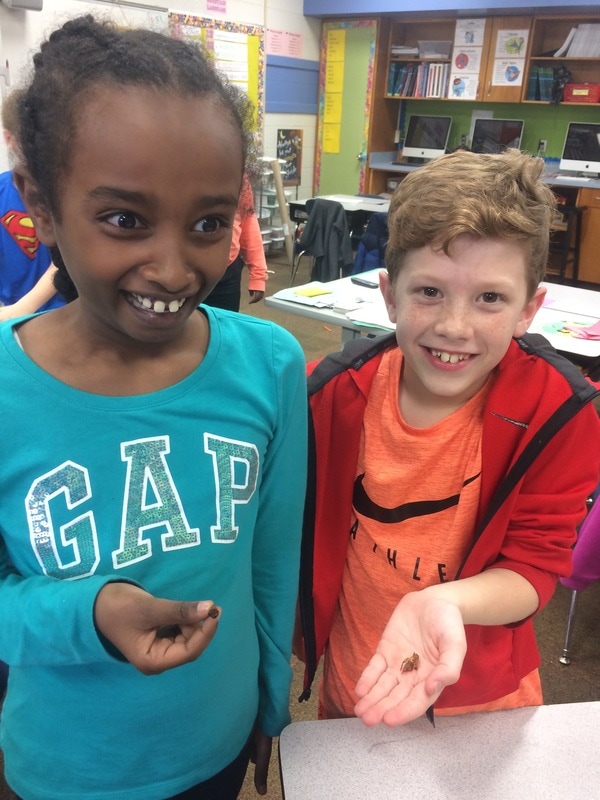In class this week we taught the last lesson of the semester, Primates. The lesson began with a review of the Archaeology lesson by asking what archaeology was. Archaeology is the study of physical remains left by past humans. After the review, we went into the Primates lesson. The Primates lesson included a review of what primates
are: monkeys, apes, and Prosimians. I then went into the differences between monkeys, apes, and humans. Monkeys are generally smaller than apes and humans and have tails. Apes are generally the largest of the three and are covered in body hair; however, they do not have tails. Humans have little to no body hair and do not have tails. I then went over the difference between great apes and lesser apes. Great apes include gorillas, chimpanzees, bonobos, orangutans, and humans. While lesser apes include gibbons. The difference between greater and lesser apes lies in their size. Greater apes are bigger than lesser apes. My lesson then went into the differences between the species of monkeys including the differences between New World monkeys and Old World monkeys. New World monkeys live in the Americas or the New World and generally have prehensile tails, meaning tails that can grasp like an extra hand or foot. These monkeys are also generally arboreal meaning they live in trees. Old World monkeys on the other hand live in the Old World which includes Asia, Africa, Europe, and India. These monkeys are typically terrestrial or ground dwelling and do not have prehensile tails. After the lesson, we went into our activities. For this lesson I had planned three activities: two to be carried out in class and one to take home as a fun activity to do with parents and siblings. For the first activity, we played capture the resources. This is played like capture the flag. Our groups were scavenging for resources like primates would in the wild. Since primates are not bipedal or walk on two legs, the kids could only “walk” on two feet and one hand while collecting resources with one hand. The group with the most resources won the game. For the next activity “Feast like a Beast” we had the kids try things primates would eat. This included various fruits, vegetables, and proteins. The kids tried guava, strawberries, mango, radish, dragon fruit, clams, and snails. The last activity was testing binocular vision. This was a handout the kids could take home with them. It included instructions on how to test your binocular vision, which is where your two eyes overlap and see the same things.
are: monkeys, apes, and Prosimians. I then went into the differences between monkeys, apes, and humans. Monkeys are generally smaller than apes and humans and have tails. Apes are generally the largest of the three and are covered in body hair; however, they do not have tails. Humans have little to no body hair and do not have tails. I then went over the difference between great apes and lesser apes. Great apes include gorillas, chimpanzees, bonobos, orangutans, and humans. While lesser apes include gibbons. The difference between greater and lesser apes lies in their size. Greater apes are bigger than lesser apes. My lesson then went into the differences between the species of monkeys including the differences between New World monkeys and Old World monkeys. New World monkeys live in the Americas or the New World and generally have prehensile tails, meaning tails that can grasp like an extra hand or foot. These monkeys are also generally arboreal meaning they live in trees. Old World monkeys on the other hand live in the Old World which includes Asia, Africa, Europe, and India. These monkeys are typically terrestrial or ground dwelling and do not have prehensile tails. After the lesson, we went into our activities. For this lesson I had planned three activities: two to be carried out in class and one to take home as a fun activity to do with parents and siblings. For the first activity, we played capture the resources. This is played like capture the flag. Our groups were scavenging for resources like primates would in the wild. Since primates are not bipedal or walk on two legs, the kids could only “walk” on two feet and one hand while collecting resources with one hand. The group with the most resources won the game. For the next activity “Feast like a Beast” we had the kids try things primates would eat. This included various fruits, vegetables, and proteins. The kids tried guava, strawberries, mango, radish, dragon fruit, clams, and snails. The last activity was testing binocular vision. This was a handout the kids could take home with them. It included instructions on how to test your binocular vision, which is where your two eyes overlap and see the same things.
To see more lessons like this one on Culture, check out our lesson plan pages on Primates.
To contact us with questions, concerns, or anything else, go to our contact page.
To see and download the exact powerpoint, lesson plan, and activity used in this blog, you can do so by clicking the links below!
To contact us with questions, concerns, or anything else, go to our contact page.
To see and download the exact powerpoint, lesson plan, and activity used in this blog, you can do so by clicking the links below!
|
| ||||



 RSS Feed
RSS Feed